There are numerous specialized books on tiles produced in one specific place or during one period.
We recommand these four recent books because they offer a comprehensive view of the use of ceramic tiles in architecture.
INMA – Institut National des Métiers d’Art

Official website of the French Federation for craft profesionals. They publish the official directory of Arts and Crafts in France. Almaviva is a member.
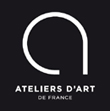
Official website of the French Federation for ceramic and glass craft profesionals. Almaviva is a member.

English version of the website of the “Ateliers d’Art de France”.

Non-commercial website presenting tile studios, mainly in the US.
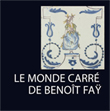
Vast collection of glazed tiles, mainly French, from the Middle-Ages to nowadays.
IMAGE GALLERY: Examples of our Medieval Tiles
The Paris-based Almaviva tile studio manufactures custom-made medieval tiles: floorings, earthenware and glazed tiles, Spanish socarrats, blue and white tin-glazed tiles, etc.
Our tiles are manufactured by hand with traditional craft techniques; therefore, they look like old tiles.
During the Middle Ages, the floors of the Romanic churches began to be covered with terracotta tiles. They were often assembled like mosaics, with tiles of different shapes. In the 12 th century, these floor tiles started to be covered with a transparent lead glaze; the usual colours were yellow, brown, and green. Further on, a more elaborate decoration of medieval tiles appears in the 13 th century.
Developed by Cistercian monks, the technique of inlaid decoration is widely used in northern Europe, mainly in France and England. A wood matrix on which is carved a pattern is pressed onto the red unbaked clay. The imprint left hollow is filled with diluted white clay called engobe. Once dry, the surface is leveled and the motif comes out very clear thanks to the contrast of colours: a yellow motif on a red background. Thereafter, the tile is covered with a lead transparent glaze.
Religious orders, rather austere, imposed geometric patterns. As the demand increased, drawings became more elaborate: images of angels or saints, lilies, coats of arms, stylized figures of animals, monsters, scenes of popular life, etc.
Under the influence of the Moors of Spain, tiles began to ornate not only floors but also walls. In this case, the robustness of the decoration is no longer necessary, and the technique of inlaid is then replaced by a decor simply painted with a white engobe, under a transparent glaze.
By the end of the Middle Ages, in Italy and Spain, a new decorating technique appears. The tiles are covered with an opaque white tin-glaze on which the decoration is directly painted: plants, rosettes, animals, or human faces announcing the early Renaissance. These blue and white tiles are produced in large numbers in the 15 th century in two villages near Valencia in Spain: Manises and Paterna. There are known there as azulejos or rajoles.
Decorated tiles are often alternated with plain terracotta tiles to decorate floors and walls: the Palais des Papes in Avignon provides a good example of this type of medieval floorings. In some case oblong hexagonal tiles are combined with square tiles to form octagons.
IMAGE GALLERY: examples of our Rennaissance majolica tiles
The Almaviva tile studio manufactures custom-made replicas of tin-glazed tiles of the Italian Renaissance.
Our tiles are handmade and hand-painted using the traditional techniques of majolica: each tile is unique. Often times, we work in the context of restoration projects; we know how to reproduce the imperfections observed on antique tiles.
Over 20 years of activity, our tile studio has gathered archives with hundreds of images of majolica tiles; they can serve as inspiration for new projects.
Our showroom is in the centre of Paris, in the Montparnasse district.
In Italy, during the 15 th century, the Florentine family Della Robbia developed a durable white tin-based enamel on which decorations could be painted. This technique, first used to protect terracotta sculptures, was used in the 1450s to decorate the floor and ceiling of the studiolo of the palace of Piero di Cosimo de’ Medici in Florence. Inspired by this illustrious example, the technique of glazed earthenware was quickly appropriated by Italian potters who used it extensively to decorate with bright colours palaces and churches, such as in Florence, Venice (San Sebastiano church), Bologna, or Siena (palazzo Petrucci).
At that time, indeed, Italy is in full artistic development (the so-called “Renaissance” period), and decorations with majolica painted in rich polichrome compositions, become very sophisticated. Arrangements of “grotesque” ornaments became popular thanks to Raphael, especially in his native region (Urbino and Casteldurante) where they are known as “raffaellesche”.
Born in Italy, this style spread throughout Europe with the installation, around 1500, of Italian majolica potters in Seville and in Antwerp. In France, the first majolica painter was Masséot Abaquesne, active in Rouen in the 1550s. Two French noble statesmen commissioned him majolica pavements for their castles of Ecouen and of La Batie d’Urfé. One is still in place (National Museum of the Renaissance, in Ecouen), the second is partly exhibited in the Louvre Museum.
IMAGE GALLERY: Examples of our Delft tiles
The Paris-based Almaviva tile studio makes replicas of Delft tiles.
Our tiles are handmade and hand-painted with the same traditional techniques as the Dutch tiles of the 17th and 18th centuries. We often work for restoration projects as our tiles have the same appearance as the original antique tiles. Over 20 years of activity, our workshop has gathered thousands of images of ancient Delft tiles, friezes, and murals. These images can be a source of inspiration for new projects.
Our showroom is in Montparnasse, in the centre of Paris.
The history of Dutch earthenware ceramic dates back to the year 1500, when three potters and painters of Italian majolica settled in Antwerp, in Flanders. Their crafstmanship immediately encountered a great succes; they hired Dutch potters and trained them with their majolica techniques. After a long war, the United Provinces won their independence from the Spanish crown in 1648; the country was then rebuilt and there was a high demand for tin-glazed tiles throughout the Netherlands.
The Dutch have always been sea merchants; between the 17th and 19th centuries tiles studios, mainly located in Delft, Utrecht and Rotterdam, obtained prestigious commissions to decorate many palaces in northern and eastern Europe. From Munich to St. Petersburg, and through the Porcelain Trianon at Versailles, these grand houses contributed to the reputation of Dutch tiles. Large decorated panels were also painted to decorate many palaces and churches in Portugal, where tiles were often used in architecture (see: almaviva.com/azulejos).
Such success over such a long period could not but encourage vocations, and Dutch tiles were widely imitated.
The city of Delft became famous for its production of tin-glazed earthenware and gave the word “Delftware“, but in reality, under this term is meant any tile produced in northern Europe: not only Dutch tiles from Rotterdam, Amsterdam or Utrecht, but also English tiles painted in London, Glasgow or Bristol, or tiles produced in current Belgium and in the Northern part of France (Lille or Desvres). Therefore, the expression “Delft tile” is more a style than a geographical origin.
Tiles often represent a central motif on a specific topic. The most common are: children’s games, flowers, animals, landscapes, boats, and biblical scenes. These tiles are also characterized by the presence of a repeated pattern in the four corners.
The blue and white tiles appear in the 17th century; the idea was to produce locally an earthenware that would imitate Chinese porcelains. Originally, in the 16th century, most Dutch tiles were painted with shimmering polychrome compositions like Italian tiles or Spanish and Portuguese azulejos.
IMAGE GALLERY: examples of our azulejos
The Paris-based Almaviva tile studio makes azulejo tiles with great respect of ceramic tradition.
We use only manual Renaissance techniques to produce tiles and tile panels. The clay is stamped by hand and decorations are hand painted with natural oxides.
We are artisans mainly commissioned tiles and murals by architects and home designers. We often work for restoration projects since our production closely resembles ancient tiles.
Over the years we have gathered a vast image library of ancient tiles and azulejo panels.
Our showroom is in the centre of Paris.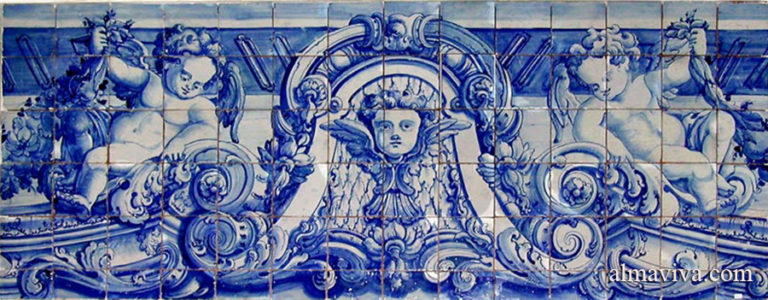
The word azulejo is derived from the Arabic word az-zulayj which means “little polished stone”. This origin shows the unmistakable Arab influence in tiles. The Moors occupied the Iberian peninsula between the 8th and the 15th century; they brought their ceramic techniques, including the opaque tin glaze. Originally, their idea was to reproduce the Greco-Roman mosaics with fragments of coloured tin-glazed tiles.
During the 12th century, tiles were cut in small pieces and assembled to create mosaics; they are known in Spain as alicatados. Later on were used cloisonné techniques known as cuerda seca (dry-string) and arista (edge). They made it possible to separate several colours on the the same tile. The city of Seville was the major centre of the Hispano-Moresque tile industry.
Wonderful examples of original Moorish tile-works can be admired in Spain in the Alhambra of Granada and the Alcazar of Seville, and in Portugal, in the Arab Room of the Sintra National Palace.
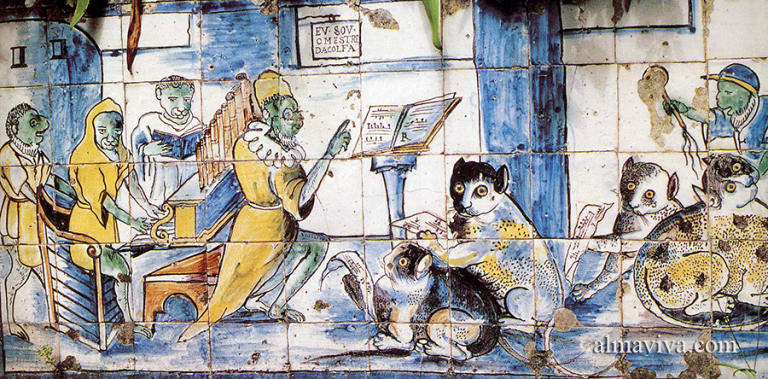
A revolution took place around 1500 under the influence of the Italian Renaissance. Then appeared the type of tiles that we usually picture nowadays as “azulejos”.
Francisco Niculoso was a painter of Italian tin-glazed pottery, known in Italy as “maiolica”. He came from Pisa and established himself in Seville in 1498. Seville tile studios had always produced tiles with geometric patterns under the Moorish influence. Niculoso started painting tiles like Italian maiolica, with smooth colour transitions. He moved from geometry to figuration with the representation of human characters, in particular religious scenes. He also introduced the so-called grotesque ornaments that had just appeared in Italy when the Domus Aurea, the palace of Nero, was excavated in Rome in the 1490s. Thanks to Niculoso tile and tile murals started depicting religious scenes, mythological characters, floral ornaments and bouquets. After Seville, these new style and techniques moved to several places such as Talavera de la Reina (province of Toledo), and the regions of Valencia and Barcelona.
Other Italians potters and maiolica painters moved to Antwerp in Flanders around 1500. Thanks to them, this new ceramic technique rapidly developed in northern Europ: Holland, England and France (see: www.delft.fr for the history of the Dutch tile).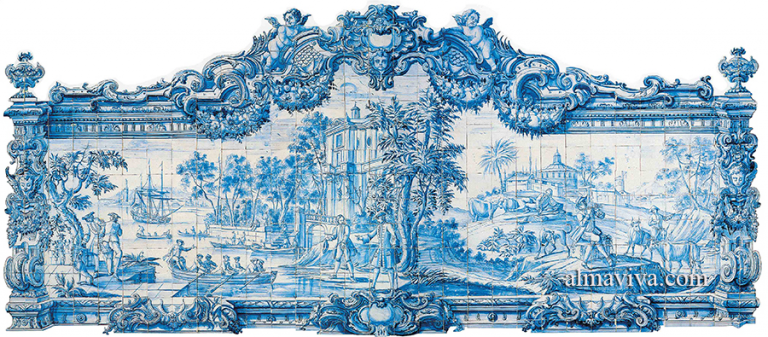
It is in Portugal that the use of tin-glazed tiles in architecture culminated. During the 17th and 18th century, palaces, churches and convents, public fountains, and complete façades were covered with tiles. Besides biblical scenes, tiles murals were depicting historical scenes such as royal weddings or famous battles, landscapes with monuments and characters, seascapes with boats, harbours and fishermen, elaborate bouquets, etc. As their Spanish predecessors, Portuguese azulejos were first polychromatic, with vivid colours. It is under the influence of blue and white Chinese porcelain that Portuguese azulejos became mostly blue and white in the early 18th century.
Ceramic tiles are still being used nowadays in Portugal. For many travellers, azulejo tiling is therefore one of the strongest elements of the Portuguese culture.